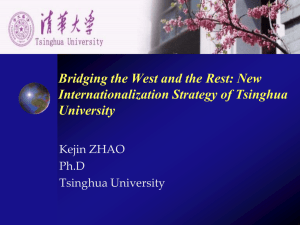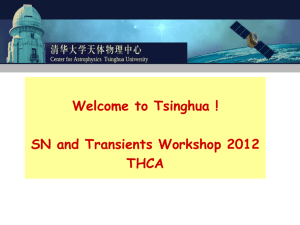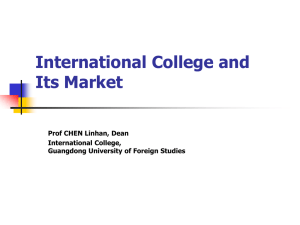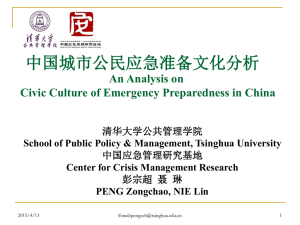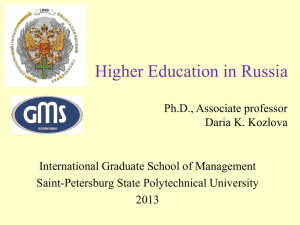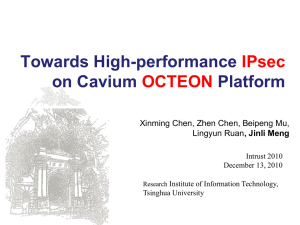Does China Have a World Class University
advertisement
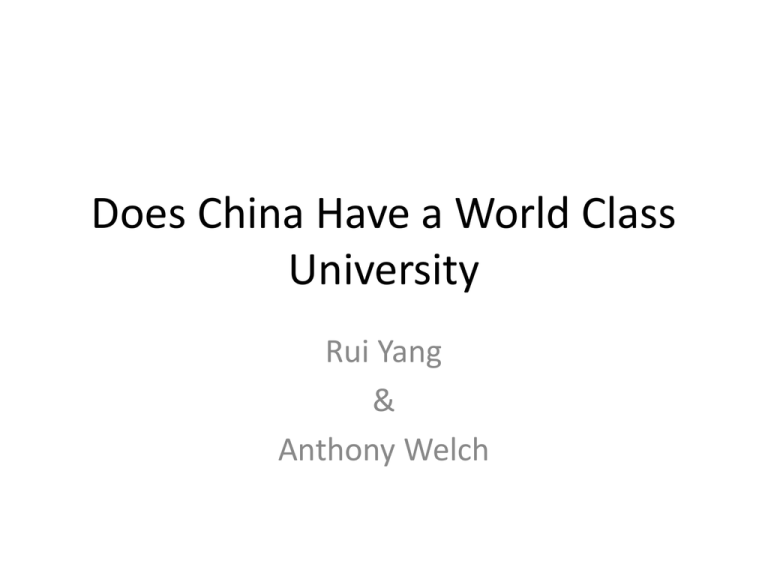
Does China Have a World Class University Rui Yang & Anthony Welch Current Benchmarks, Future Plans • According to Xu Zhihong, “China doesn’t have world-first-class universities at the moment.” • For such an institution, 3 benchmarks are needed: intn’lly. renowned Profs. doing key research; research that has had profound impact on human civilization and social development; and graduates that have made contributions to human civilization. • Even so, China has selected key universities for special development and China’s Medium and Long-Term Program for Education Reform and Development 2010-2020 includes plans for several such universities to be “at or near world-class level”. • Realistic? Xu Zhihong: Creating world-class Universities takes time, and programmes such as 985 desire ‘instant success’. Rankings & China’s Universities Chinese Constraints • Is China perhaps too ambitious for immediate results, and what effects might this have? • “ … a lot of the mainland’s investment in science and technology was lost to corruption. A substantial amount of the scientific research funds are being spent on meetings trips or buying expensive equipment that is rarely used. Some (Chinese scientists) even resort to stealing others’ work, or simply making up the data to get a paper published.” (Guang, Zhongcheng, 2010) Measuring Up: Tsinghua • As China’s leading university, esp. in science and technology, Tsinghua provides a good test case for evaluating China’s bid for world-class Universities. • Tsinghua has its own ambitions to join the top tier. • Although TU began life as a prep. college for intending overseas students (to USA), and its university status dates from 1925, its plans for its centenary next year are already well advanced. Tsinghua Profile • Tsinghua University has 13 colleges and 55 departments, including since September 2006, Peking Union Medical College, Tsinghua University. • Notably alumni include notable Nobel laureates in Yang Chen-ning and Lee Tsung-dao (Physics), and national leaders including Hu Jintao and Zhu Rongji. • Its own strategic plans include comprehensively lifting its overall level to world-class standards during the coming decade (2010-2020). Teaching (1) • Strengthening academic disciplines has been fundamental in Tsinghua’s development. • Multi-disciplinary approaches have also been fostered, since the 1980s. • More recently, in addition to its strengths in science and technology, Schools of Humanities and Social Sciences, Law, Public Administration, and Journalism and Communication were successively founded. In 1999, the Academy of Arts and Design was developed, through amalgamation of the previous Central Academy of Arts and Design. • Doctoral programmes now exist in philosophy, economics, law, sociology, Marxist theory, Chinese language and literature, journalism and communication, theory of art, management science and engineering, business administration, and public administration. • But much remains to be done to lift Tsinghua’s profile in social sciences and humanities, relative to both Peking U., and certainly relative to major overseas competitors. Teaching (2) • Recent innovations include freshmen seminars, senior seminars, discovery learning, research training programs for students, undergraduate research opportunities programs, summer undergraduate research fellowship programs, undergraduate research apprentice programs, and research experiences for undergraduates. • An emphasis on post-graduate students at Tsinghua has meant a need for more supervisors. • In 2007, three Tsinghua professors were listed as national master teachers, 19 courses were included in a list of “national treasures,” and 11 doctoral theses were ranked among the best nationally. • 16 of Tsinghua’s 19 disciplines were ranked in the top five among all Chinese universities, and eight were ranked number one, making Tsinghua the best performer nationwide. • On a variety of other rankings, Tsinghua’s postgraduate training has been consistently ranked as the nation’s top, yet still falls short. 23% of Tsinghua undergraduates reported they had never raised a question or participated in class discussions, while 34.6% had never done a class presentation. Research (1) • Tsinghua has long played a key role in China’s national innovation system, because of the quality of its research, its targeting of national strategic needs and cultivation of strong links with government. • President Gu Bingli (2010): “Tsinghua’s important mission (is) to accomplish the key projects designated by our country.” • This has included such high-tech achievements as China’s HTR-10 High Temperature Gas-Cooled Reactor, completed as a key project of the prestigious State 863 Plan. • By 2009, Tsingua could boast more SCI citations than any other Chinese university. • Its total of SCI-listed publications and citations increased by 85% and 135% respectively, 2003-2006. • BUT, although the per capita SCI and SSCI publications of Tsinghua was 1.56 during 2003-5, (far ahead of all other mainland Chinese universities), this was still behind five universities (of 8 UGC funded institutions) in Hong Kong, and three in Taiwan. Research (2) • Moreover, some studies show greater quantitative than qualitative improvement in China overall (Mohrmann 2006, 2010; OECD 2008). • Further, even more than its neighbours, China’s universities contribute modestly to overall R&D; China’s H/Ed. sector contributes only 10.5% to overall R&D, compared to 15.7% across SE Asia, and 27.0% developed world average (ADB 2008). • But when MIT and Tsinghua were compared, on key performance indicators, 1995-2005, the latter’s increase over the decade looks highly impressive. • Tsinghua has also successfully spun off numerous successful applied technology companies, in partnership with enterprises. • On the social sciences front, however, achievements are much less prominent: from 1997 to 2004, a total of 509 SSCI publications were produced by Chinese universities. Tsinghua contributed 109, second only to Peking University’s 264. An Eye to The Future • • • • • • • A striking feature of the Chinese system is the degree of commitment by both institutions and governments to the quest for world-class universities. Government works closely with universities, with supportive policies and impressive levels of investment, esp. in designated key universities. Ranked 18th and 12th in 1992 and 1998 , China overtook Japan and the United Kingdom in 2006 to become the world’s second largest producer of research papers. Within 10 years, China will rank No. 1. SJTU ranking (2010): Beida and Tsinghua in top 200; Fudan, Nanjing, Shanghai Jiao Tong, University of Science and Technology of China, and Zhejiang in top 300, Shandong, Sichuan and Sun Yat-sen in top 400, and another 12 in top 500. But, if academic independence is a sine qua non of academic excellence, then Tsinghua is hampered by both its close and strategic links to govt., and the Chinese tradition, in which zhizhu (自主) is more powerful than zhizhi (自治), which indicates greater autonomy. China devotes only about 5% of R & D funds to basic research, cf. 10-30% in developed countries. In sum, China has much to contribute to the global knowledge system, and there is no doubt that China’s universities will, over time, compete with the best. Of these, Tsinghua is bound to be one. University Contributions to R&D Performance, by sector. • • • • • • • • • • • • • • • • • • • • • • Country/Region Business Government Higher Education SE Asia 51.3 22.1 15.7 India 23 72 8 China 62.4 27.1 10.5 Developed World Average 62.9 13.3 27.0 India estimates from OECD R&D database 2007, as in Fig 1-5, World Bank 2007, p. 9.


